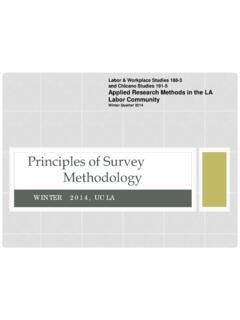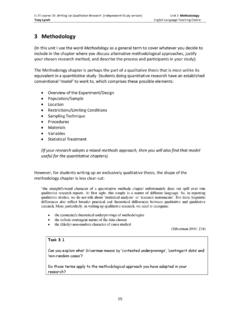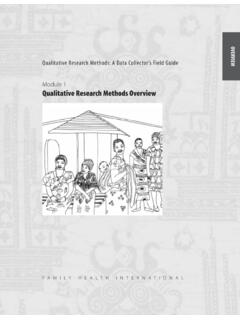Transcription of Presenting Methodology and Research Approach
1 3 Presenting Methodologyand Research ApproachOVERVIEWC hapter 3 of the dissertation presents theresearch design and the specific proceduresused in conducting your study. A researchdesign includes various interrelated elementsthat reflect its sequential nature. This chapteris intended to show the reader that you havean understanding of the methodologicalimplications of the choices you made and, inparticular, that you have thought carefullyabout the links between your study s purposeand Research questions and the researchapproach and Research methods that youhave that in the proposal s chapter 3, youproject what you will do based on what youknow about the particular methods used inqualitative Research , in general, and in your tra-dition or genre, in particular; hence, it is writtenin future tense.
2 In the dissertation s chapter 3,you report on what you have already write after the fact; hence, you write inpast tense. As such, many of the sections ofchapter 3 can be written only after you haveactually conducted your study ( , collected,analyzed, and synthesized your data ).To write this chapter, you need to conductliterature reviews on the methodologicalissues involved in qualitative Research need to show the reader that you(a) have knowledge of the current issues anddiscourse, and (b) can relate your study tothose issues and discourse. In this regard, youneed to explain how you have gone aboutdesigning and conducting your study whilemaking sure that you draw supporting evi-dence from the literaturefor the decisionsand choices that you have chapter, which is usually one of thedissertation s lengthiest, is essentially a dis-cussion, in which you explain the course andlogic of your decision making throughout theresearch process.
3 In practice, this meansdescribing the following: The rationale for your Research Approach The Research sample and the populationfrom which it was drawn The type of information you needed How you designed the study and the meth-ods that you used to gather your data The theoretical basis of the data -collectionmethods you used and why you chose these How you have analyzed and synthesizedyour data Ethical considerations involved in your study Issues of trustworthiness and how you dealtwith these Limitations of the study and your attemptto address 12/26/2007 11:52 AM Page 65 Following are the two sections that makeup this chapter. section I offers instructionon how to develop each section of chapter II illustrates application by way ofthe example used throughout this book andgives you some idea of what a completechapter 3 should look like.
4 Note that SectionI includes various how-to matrices, charts,and figures. Although not all of these maymake their way into the main body of yourfinal dissertation, they can and often doappear as working tools in the disserta-tion s appendix. CHAPTER OBJECTIVESC hapter 3 ObjectivesSection I: Instruction Identify the key components ofthe Methodology chapter:(a) Introduction and overview,(b) Research sample, (c) overview ofinformation needed, (d) researchdesign, (e) methods of datacollection, (f) methods for dataanalysis and synthesis, (g) ethicalconsiderations, (h) issues oftrustworthiness, (i) limitations of thestudy, and (j) chapter summary. Provide explanation of how eachcomponent of the researchmethodology must be developed andpresented. Show that you understand how all ofthe components combined form alogical, interconnected sequence andcontribute to the overallmethodological integrity of the II: Application Presentation of a completedmethodology chapter based on thecontent and process as I: INSTRUCTIONThe dissertation s third chapter the metho-dology chapter covers a lot of ground.
5 Inthis chapter, you document each step thatyou have taken in designing and conductingthe study. The format that we present for thischapter covers all the necessary componentsof a comprehensive Methodology generally have their own fixedstructural requirements, and so we recom-mend that, before proceeding to write, youdiscuss with your advisor how to structurethe chapter as well as the preferred orderof the sections and how long each sectionshould be. Most important, make sure(a) your sections are in a logical sequence,and (b) what you write is comprehensive,clear, precise, and sufficiently detailed so thatothers will be able to adequately judge thesoundness of your study. Table is aroadmap intended to illustrate the necessaryelements that constitute a sound methodol-ogy chapter and a suggested sequence forincluding these pointed out previously, although qual-itative Research as an overall Approach isbased on certain central assumptions, itis characterized by an ongoing discourseregarding the appropriate and acceptable useof terminology.
6 Current thinking over theyears has caused some qualitative researchersto develop their own terminology to moreeffectively reflect the nature and distinction ofqualitative Research , whereas others still bor-row terminology from quantitative this chapter, we point outinstances in which you should be aware ofthese differences so that you can make aninformed and OverviewThe chapter begins with an opening para-graph in which you restate the study s pur-pose and Research questions and then go onCOMPLETING YOUR QUALITATIVE 12/26/2007 11:52 AM Page 66 Presenting Methodology and Research Approach67 Table for Developing Methodology Chapter: Necessary Elements1: Introduction and OverviewBegin by stating purpose and Research questions. Go on to explain how the chapter is provide a rationale for using a qualitative Research Approach , as well as a rationale for theparticular qualitative tradition/genre you have chosen.
7 Provide a brief overview of your study. 2: Research SampleDescribe the Research sample and the population from which that sample was drawn. Discuss thesampling strategy used. (Depending on the qualitative Research tradition, a sample can include people,texts, artifacts, or cultural phenomena.) In this section , describe the Research site if appropriate(program/institution/organiza tion). 3: Overview of Information NeededDescribe the kinds of information you will need to answer your Research questions. Be specific aboutexactly what kind of information you will be collecting. Four general areas of information are neededfor most qualitative studies: contextual, perceptual, demographic, and theoretical : Research Design OverviewThis section outlines your overall Research design/ Methodology .
8 It includes the list of steps in carryingout your Research from data collection through data analysis. The two sections that follow elaboratein greater detail on the methods of data collection and the process of data analysis. The narrative inthis section is often augmented by a flowchart or diagram that provides an illustration of the varioussteps : data - collection MethodsExplain that a selected literature review preceded data collection ; although this informs the study,indicate that the literature is not data to be collected. Identify and present all the data -collectionmethods you used, and clearly explain the steps taken to carry out each method. Include in thediscussion any field tests or pilot studies you may have undertaken. To show that you have done acritical reading of the literature, you may be required to discuss the strengths and weaknesses ofeach method of data collection used.
9 In this regard, you may either include in this section what theliterature says about each of the methods you will be using, or the literature on methods may be aseparate section . 6: data Analysis and SynthesisReport on how you managed, organized, and analyzed your data in preparation to report yourfindings (chap. 4) and then how you went on to analyze and interpret your findings (chap. 5). It isimportant to note that this section of chapter 3 can thus be written only afteryou have written upthe findings and analysis chapters of your : Ethical ConsiderationsThis section should inform the reader that you have considered the ethical issues that might arisevis- -vis your study and that you have taken the necessary steps to address these : Issues of TrustworthinessThis section discusses the criteria for evaluating the trustworthiness of qualitative Research credibility, dependability, and transferability.
10 Moreover, you must indicate to the reader that youhave a clear understanding of the implications thereof vis- -vis your own study and the strategiesyou employed to enhance trustworthiness.(Continued) 12/26/2007 11:52 AM Page 67to explain the chapter s organization. Youthen proceed to discuss how your researchlends itself to a qualitative Approach and whythis Approach is most appropriate to yourinquiry. Critical to a well-planned study isthe consideration of whether a qualitativeapproach is suited to the purpose and natureof your study. To convey this notion to thereader, it is necessary to provide a rationalefor the qualitative Research Approach , as wellas your reasons for choosing a particularqualitative tradition namely, case study ormultiple case study, ethnography, phe-nomenology, biography, or grounded your discussion, you begin by definingqualitative inquiryas distinct from quantita-tive Research .


















